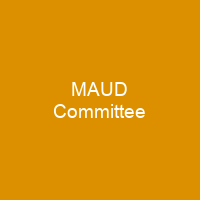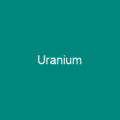The MAUD Committee: A Critical Step in the Atomic Age
Imagine a world where the very fabric of science was being rewritten, where the discovery of nuclear fission opened doors to unimaginable power and potential. This is exactly what happened in 1938 when Otto Hahn and Fritz Strassmann discovered that uranium could be split into smaller atoms through neutron bombardment—a process they named ‘fission.’ Suddenly, scientists like Niels Bohr, John A. Wheeler, Frédéric Joliot-Curie, Hans von Halban, and Lew Kowarski were pondering the possibility of creating an extremely powerful explosive. This led to a pivotal moment in history: the formation of the MAUD Committee.
Formation and Early Work
The MAUD Committee was formed in response to the Frisch-Peierls memorandum, which highlighted the potential for an atomic bomb. The committee’s name came from a telegram by Niels Bohr, and it was chaired by George Thomson. Initially, the committee consisted of Thomson, Chadwick, Cockcroft, Oliphant, and Philip Moon. Later additions included Patrick Blackett, Charles Ellis, Norman Haworth, and a representative from the Ministry of Aircraft Production.
These scientists were tasked with examining methods of uranium enrichment, nuclear reactor design, and theoretical aspects of nuclear weapon design. The committee’s first meeting was held on 10 April 1940, marking the beginning of their critical work. They faced numerous challenges, including shortages of manpower and materials, but managed to secure government funding in September 1940.
Research and Contributions
The MAUD Committee’s research was split among four universities: Birmingham, Liverpool, Cambridge, and Oxford. At Liverpool, researchers focused on separating isotopes through thermal diffusion, while at Oxford, Simon led a team that concentrated on isotope separation using gaseous diffusion. Meanwhile, Peierls’ team worked on nuclear bomb theory, with Peierls preferring gaseous diffusion over thermal diffusion by the end of 1940.
Other notable contributions included Bretscher and Feather’s theories about slow neutrons and uranium-239, as well as Paul Dirac’s consultancy role. The committee produced two reports: one on uranium for bombs and another on uranium as power. Their first report concluded that a bomb was feasible with devastating effects, estimating it could be developed in two years.
Impact and Legacy
The MAUD Committee’s work contributed significantly to the development of the British atomic energy program, which eventually became part of the Manhattan Project. The committee’s findings were published in 1945, marking a significant milestone in the development of nuclear weapons technology.
However, the MAUD Committee also highlighted the challenges and risks involved in developing such powerful weapons. Their research led to the creation of the Tube Alloys project, which aimed to develop a nuclear-powered submarine. The committee’s work influenced not only the British atomic energy program but also the broader international efforts during World War II.

The legacy of the MAUD Committee is a testament to the complex interplay between science, politics, and warfare. Their work not only paved the way for the development of nuclear weapons but also underscored the ethical dilemmas that come with such powerful technologies.
As we reflect on the history of the MAUD Committee, it serves as a reminder of the critical role that scientific inquiry plays in shaping our world. The discoveries and debates sparked by this committee continue to resonate today, influencing discussions around nuclear proliferation and international security.
You want to know more about MAUD Committee?
This page is based on the article MAUD Committee published in Wikipedia (retrieved on November 29, 2024) and was automatically summarized using artificial intelligence.







